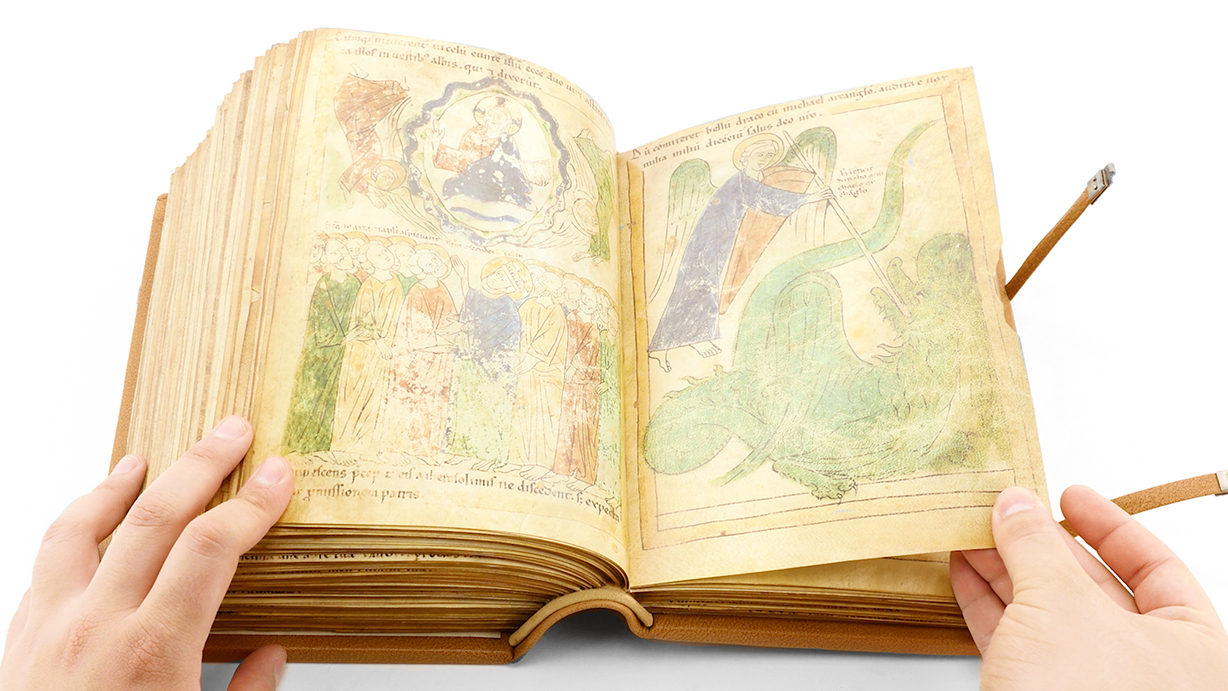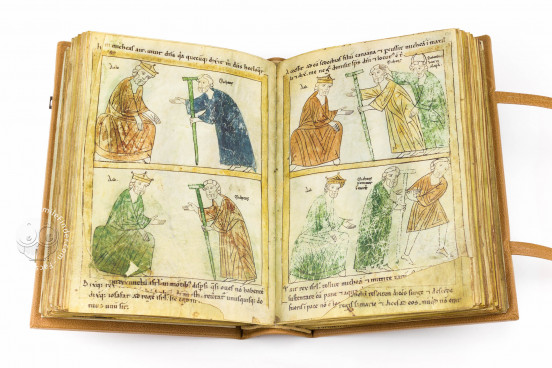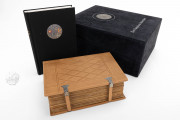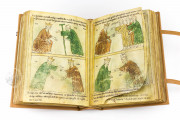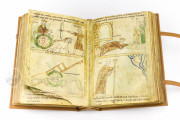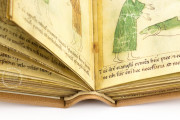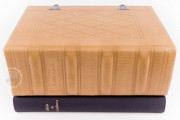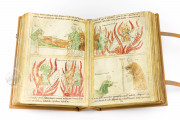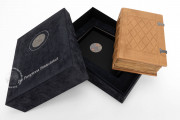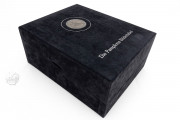The Augsburg Pamplona Bible is a Christian picture book comprising scenes from the Old and New Testaments, as well as legends of saints and the end times. It was created in Pamplona around 1197, presumably at the behest of Sancho VII, "the strong," King of Navarre. With nearly 1,000 surviving scenes, it is an enormous compendium of visual material. The miniatures take the form of line drawings with judicious application of color, gold, and silver. They are distinguished by lively interaction among the protagonists.
Petrus Ferrandus—probably Sancho's chancellor—determined the picture book's contents. He may also have been the scribe of the descriptions of the events depicted. Among the sources for the texts are the Bible, biblical apocrypha, saints' lives, and the prophecies of the Tiburtine Sybil.
One of a Pair
The Augsburg Pamplona Bible has a twin in the Amiens Pamplona Bible (Amiens, Bibliothèques d'Amiens Métropole, MS 108). The Amiens manuscript has an extensive colophon indicating that it was "composed" by Petrus for Sancho and completed in 1197. Scholars assume that Sancho also commissioned the Augsburg manuscript, which may have been intended as a gift to one of his sisters, given the large number of female saints included (fols. 246-266).
An Expert Team of Artists
The artists working on the ambitious project were well-organized and disciplined. There are few errors, and the outlines are firmly and expertly drawn. The compositions rely little on existing visual tradition, partly because so many scenes are rarely found in art.
The frames for the miniatures were drawn first, followed by the writing of texts describing the episodes to be depicted. Only then were the drawings and the short captions within the miniatures executed, generally following the descriptions. There are some variations from the Amiens manuscript, and the drawings may have been devised directly from the texts.
Emphasis on Storytelling
The drawings focus on narrative. Indeed, the choice of biblical episodes facilitated this. Whole books of the Bible are unrepresented in the manuscript, including wisdom literature of the Old Testament and the Epistles of the New.
The artists consistently highlight action. In the miniature of the Resurrection of the Son of the Widow of Nain, for example, the image captures both the essence of the boy's return to life and the fact that he immediately begins to talk (fol. 199v). Even in the stately presentation of the scene of David slaying Goliath, the artist depicts both the stone hitting the mounted Goliath and David unleashing it (fols. 100v-101r).
The episodes are also frequently enlivened by details that evoke contemporary life. For example, in the miniature of Saul dressing David for his battle with Goliath, David is covered head to toe in chainmail, calling attention to the boy warrior's size and bringing the scene into the present (fol. 100r).
Focus on Genealogy
The Augsburg manuscript includes forty miniatures dedicated to the genealogy of Christ (fols. 177-186). This sequence is absent from the Amiens manuscript and may reflect contemporary concerns about succession at the court of Sancho, who died without an heir.
Visual Litany
The section devoted to the saints reflects the arrangement of a litany, starting with Saint Michael and the male saints of apostolic times and concluding with female saints (fols. 213-266). As in the scenes illustrating biblical events, the emphasis is on storytelling, with some saints accorded multiple miniatures.
"Discovered" in 1809
The manuscript first appeared in Valladolid in 1809 and was soon thereafter (1814) purchased by Ludwig (1791-1870), Prince of Oettingen-Wallerstein from Charles-Philippe Campion de Tersan (1736-1819). It became a part of the public Oettingen-Wallersteinsche Bibliothek in 1814. That library was purchased by the Bavarian government in 1980 and absorbed into the Universitätsbibliothek Augsburg.
We have 1 facsimile edition of the manuscript "Augsburg Pamplona Bible": Biblia de Pamplona facsimile edition, published by Eikon Editores, 2005
Request Info / Price
